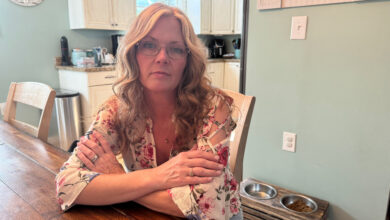Want Vulnerable Californians to Have Healthier Pregnancies? Doulas Say the State Must Pay Up.

SACRAMENTO, Calif. — This was supposed to be the year that low-income Californians could hire a doula to guide them through pregnancy and advocate for them in the hospital.
But the new benefit for people enrolled in Medi-Cal, the state’s Medicaid health insurance program, has been delayed twice as the state and doulas — nonmedical workers who help parents before, during, and after birth — haggle over how much they should get paid.
The state initially proposed a flat rate of $450 per birth, covering all prenatal and postnatal visits, on-call time during the pregnancy, and labor and delivery — which often lasts 12 or more hours.
Doulas say that amount is too low, and far less than their clients would pay out-of-pocket. It’s also below what doulas receive from Medicaid programs in most other states that offer the benefit.
The only state that pays less is Oregon, where doulas receive up to $350 per birth. The reimbursement rates of other states that offer doula services through Medicaid are usually between $770 and $900. When Rhode Island implements its benefit in July, it will be the highest-paying state, offering doulas up to $1,500.
In most states that offer a doula benefit, the rate Medicaid programs pay is a maximum, which doulas receive if the patient attends every prenatal and postnatal visit. Unlike obstetricians, who see many patients in a day, most doulas accept only a few clients a month.
“We’re talking six to nine months of face time, screen time, texting time, research, resources, and dollars. $450? That’s wild,” said Chantel Runnels, a doula in Riverside County, California, who usually charges clients about $1,000.
“It feels limiting,” Runnels said. “Like there is no value on our time.”
Doulas do not deliver babies. They provide resources to navigate the health care system, information on sleep or nutrition, and postpartum coaching and lactation support. They also support mothers during birth to make sure their wishes are being respected by the hospital.
Doulas are unregulated, and most of their work is for patients who pay out-of-pocket. Most private insurance does not cover doulas, said Cassondra Marshall, an assistant professor at the University of California-Berkeley School of Public Health who has conducted research on doulas in the Bay Area. Tricare, the health insurance program for active-duty members of the military, began covering doulas this year, paying them about $970 for labor support and six visits.
The structure of California’s benefit is still being determined. Doulas and the state aren’t in sync on credentialing and training — in addition to pay, said Anthony Cava, a spokesperson for the California Department of Health Care Services, which administers Medi-Cal. Doulas also told the state they want to bill separately for labor and prenatal and postnatal visits, instead of receiving a bundled flat rate.
The state “recognizes rates must be adequate” to attract enough providers and reduce health disparities, Cava said in a statement. “We are considering input received from the doula stakeholders, and are also reviewing other states’ doula programs and their payment structures and associated rates for similar services,” Cava said.
Cava said the state’s $450 proposal was modeled after the rates in other states, including Oregon, which was one of the first states to include doula benefits in its Medicaid package, in 2014.
But Oregon’s $350 maximum payment is too low to attract enough doulas, said Amy Chen, a senior attorney with the National Health Law Program who studies doula Medicaid benefits across states. “One of the big challenges is that the reimbursement rate is so low that doulas just can’t do it,” Chen said.
From 2018 through 2021, Oregon paid for doulas in 310 births, about 0.39% of the births to Medicaid enrollees during that period, according to state officials.
It’s a “lower uptake” than the state had hoped for, Oregon Health Authority spokesperson Aria Seligmann said in a statement. We’re “currently reevaluating the reimbursement rate to ensure doulas’ services are appropriately valued,” Seligmann said.
Doulas in Oregon must spend about 100 hours learning how to charge Medicaid and must upgrade their software, phones, and medical record systems to comply with privacy laws — all on their own dime, said Raeben Nolan, vice president of the Oregon Doula Association. “Very few people are willing to go through the hoops,” Nolan said.
Five Medicaid programs offer a doula benefit, and six more (including California’s) are implementing one soon.
Offering a doula benefit in Medi-Cal is one of the as-yet-unfulfilled promises of the “Momnibus” Act that was signed by Gov. Gavin Newsom last year. Lawmakers and advocates hope that by providing doulas to the state’s poorest and most vulnerable women, California will help address racial disparities, improve birth outcomes, and diversify and expand its health care workforce. The benefit was originally supposed to kick in Jan. 1 but is now slated to start in January 2023 — if doulas and the state can come to an agreement.
California is embarking on a massive transformation of its Medicaid program that will expand benefits beyond health care and into the realm of social services. As part of this transformation, the state plans to bring several types of nontraditional health care workers into the Medi-Cal workforce, including promotores, peer mental health counselors, and doulas.
The maternal mortality rate is rising nationally, and the rate for Black mothers is nearly three times that of white mothers. Studies have associated doula care with a range of better birth outcomes, such as lower rates of cesarean sections, fewer babies with low birth weights, and more breastfeeding.
Since 2019, at least 10 pilot programs around California have provided doula services to Black parents or Medi-Cal enrollees, funded by a mix of public funds, grants, and private insurance. The services were free to patients, and participating doulas were paid a maximum of $1,000 per birth in Riverside County to $3,000 in Alameda County.
TaNefer Camara is a maternal health strategist in Oakland, where she charges $3,000 for doula work. She became a doula to help other women of color but said she couldn’t take on many Medi-Cal patients at what she called the “laughable” rate of $450. “You don’t need to go into poverty to try and fix a situation such as maternal health care,” she said.
Marshall, of UC-Berkeley, found that doulas who were paid a flat rate for all their services often had to work multiple jobs to make ends meet. “The flat rate lump sums aren’t nearly enough for all that they’re doing,” Marshall said.
Minnesota has been offering a doula benefit since 2014. But the state found that a maximum reimbursement rate of $411 was too low, and the legislature increased it in 2019 to $770.
California’s proposed rate is off base, said Ashley Kidd-Tatge, a doula and the doula coordinator at Everyday Miracles, a nonprofit organization that matches Medicaid beneficiaries with doulas in the Twin Cities. Most doulas in her area charge non-Medicaid patients $800 to $1,500 per birth.
“$450 is incredibly low,” Kidd-Tatge said. “I don’t know too many folks, even in the Twin Cities, who would entertain that rate.”
This story was produced by KHN, which publishes California Healthline, an editorially independent service of the California Health Care Foundation.
KHN (Kaiser Health News) is a national newsroom that produces in-depth journalism about health issues. Together with Policy Analysis and Polling, KHN is one of the three major operating programs at KFF (Kaiser Family Foundation). KFF is an endowed nonprofit organization providing information on health issues to the nation.
USE OUR CONTENT
This story can be republished for free (details).


